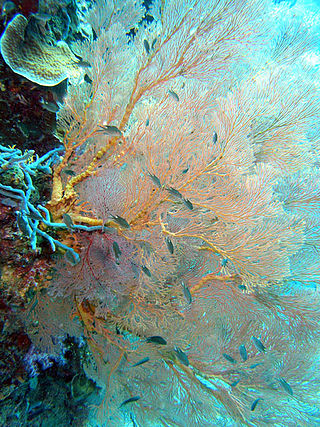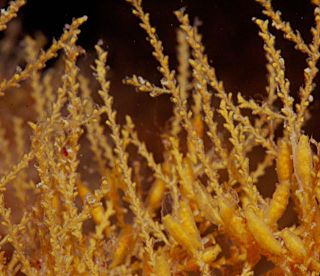
The list of marine cnidarians of South Africa is a list of saltwater species that form a part of the cnidarian (Phylum Cnidaria) fauna of South Africa. This list does not include the freshwater cnidarians. The list follows the SANBI listing on iNaturalist, and does not always agree with WoRMS for distribution.
Contents
- Class Anthozoa, subclass Hexacorallia
- Order Actiniaria, suborder Endocoelantheae
- Suborder Nynantheae, infraorder Athenaria
- Infraorder Thenaria
- Suborder Ptychodacteae
- Order Antipatharia
- Order Ceriantharia, suborder Spirularia
- Order Corallimorpharia
- Order Scleractinia
- Order Zoantharia, suborder Brachycnemina
- Suborder Macrocnemina
- Subclass Octocorallia
- Order Alcyonacea, suborder Alcyoniina
- Order Calcaxonia
- Subrder Holaxonia
- Suborder Scleraxonia
- Suborder Stolonifera
- Order Pennatulacea
- Suborder Sessiliflorae
- suborder Subsessiliflorae
- Class Cubozoa
- Order Carybdeida
- Order Chirodropida
- Class Hydrozoa, subclass Hydroidolina
- Order Anthoathecata, suborder Aplanulata
- Suborder Capitata
- Suborder Filifera
- Order Leptothecata
- Order Siphonophorae, suborder Calycophorae
- Suborder Cystonectae
- Suborder Physonectae
- Subclass Trachylinae
- Order Limnomedusae
- Order Narcomedusae
- Order Trachymedusae
- Class Scyphozoa
- Order Coronatae
- Order Carybdeida 2
- Order Rhizostomeae, suborder Kolpophorae
- Suborder Daktyliophorae
- Order Semaeostomeae
- Class Staurozoa
- Order Stauromedusae, suborder Cleistocarpida
- Notes
- References
Cnidaria ( /nɪˈdɛəriə,naɪ-/ ) is a phylum under kingdom Animalia containing over 11,000 species of aquatic animals found both in freshwater and marine environments, predominantly the latter.
Their distinguishing feature is cnidocytes, specialized cells that they use mainly for capturing prey. Their bodies consist of mesoglea, a non-living jelly-like substance, sandwiched between two layers of epithelium that are mostly one cell thick.
Cnidarians mostly have two basic body forms: swimming medusae and sessile polyps, both of which are radially symmetrical with mouths surrounded by tentacles that bear cnidocytes. Both forms have a single orifice and body cavity that are used for digestion and respiration. Many cnidarian species produce colonies that are single organisms composed of medusa-like or polyp-like zooids, or both (hence they are trimorphic). Cnidarians' activities are coordinated by a decentralized nerve net and simple receptors. Several free-swimming species of Cubozoa and Scyphozoa possess balance-sensing statocysts, and some have simple eyes. Not all cnidarians reproduce sexually, but many species have complex life cycles of asexual polyp stages and sexual medusae stages. Some, however, omit either the polyp or the medusa stage, and the parasitic classes evolved to have neither form.
Cnidarians were formerly grouped with ctenophores in the phylum Coelenterata, but increasing awareness of their differences caused them to be placed in separate phyla. Cnidarians are classified into four main groups: the almost wholly sessile Anthozoa (sea anemones, corals, sea pens); swimming Scyphozoa (jellyfish); Cubozoa (box jellies); and Hydrozoa (a diverse group that includes all the freshwater cnidarians as well as many marine forms, and has both sessile members, such as Hydra , and colonial swimmers, such as the Portuguese Man o' War). Staurozoa have recently been recognised as a class in their own right rather than a sub-group of Scyphozoa, and the highly derived parasitic Myxozoa and Polypodiozoa were firmly recognized as cnidarians in 2007.
Most cnidarians prey on organisms ranging in size from plankton to animals several times larger than themselves, but many obtain much of their nutrition from dinoflagellates, and a few are parasites. Many are preyed on by other animals including starfish, sea slugs, fish, turtles, and even other cnidarians. Many scleractinian corals—which form the structural foundation for coral reefs—possess polyps that are filled with symbiotic photo-synthetic zooxanthellae. While reef-forming corals are almost entirely restricted to warm and shallow marine waters, other cnidarians can be found at great depths, in polar regions, and in freshwater.
Recent phylogenetic analyses support monophyly of cnidarians, as well as the position of cnidarians as the sister group of bilaterians. Fossil cnidarians have been found in rocks formed about 580 million years ago, and other fossils show that corals may have been present shortly before 490 million years ago and diversified a few million years later. However, molecular clock analysis of mitochondrial genes suggests a much older age for the crown group of cnidarians, estimated around 741 million years ago, almost 200 million years before the Cambrian period as well as any fossils. ( Full article... )













